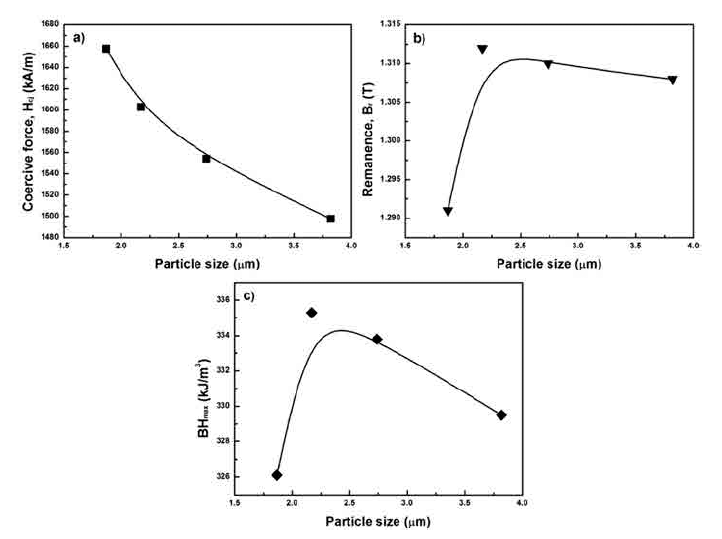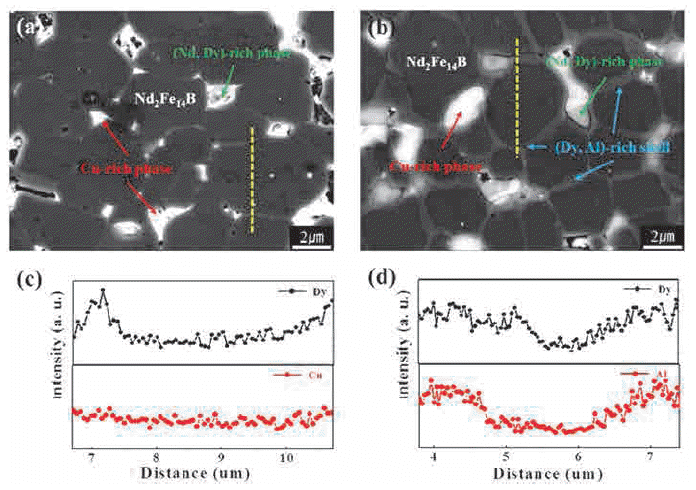Search
- Page Path
- HOME > Search
- [Korean]
- Microstructure and Magnetic Properties of Nd-Fe-B Sintered Magnet with the Variation of Particle Size
- Dongwon Shin, Dong-Hwan Kim, Young-Cheol Park, Jeong-Gon Kim
- J Korean Powder Metall Inst. 2016;23(6):447-452. Published online December 1, 2016
- DOI: https://doi.org/10.4150/KPMI.2016.23.6.447

- 419 View
- 2 Download
-
 Abstract
Abstract
 PDF
PDF Neodymium-iron-boron (Nd-Fe-B) sintered magnets have excellent magnetic properties such as the remanence, coercive force, and the maximum energy product compared to other hard magnetic materials. The coercive force of Nd-Fe-B sintered magnets is improved by the addition of heavy rare earth elements such as dysprosium and terbium instead of neodymium. Then, the magnetocrystalline anisotropy of Nd-Fe-B sintered magnets increases. However, additional elements have increased the production cost of Nd-Fe-B sintered magnets. Hence, a study on the control of the microstructure of Nd-Fe-B magnets is being conducted. As the coercive force of magnets improves, the grain size of the Nd2Fe14B grain is close to 300 nm because they are nucleation-type magnets. In this study, fine particles of Nd-Fe-B are prepared with various grinding energies in the pulverization process used for preparing sintered magnets, and the microstructure and magnetic properties of the magnets are investigated.
- [Korean]
- Effect of Cu/Al powder mixing on Dy diffusion in Nd-Fe-B sintered magnets treated with a grain boundary diffusion process
- Min Woo Lee, Tae Suk Jang
- J Korean Powder Metall Inst. 2016;23(6):432-436. Published online December 1, 2016
- DOI: https://doi.org/10.4150/KPMI.2016.23.6.432

- 612 View
- 5 Download
- 1 Citations
-
 Abstract
Abstract
 PDF
PDF We investigate the microstructural and magnetic property changes of DyH2, Cu + DyH2, and Al + DyH2 diffusion-treated NdFeB sintered magnets with the post annealing (PA) temperature. The coercivity of all the diffusiontreated magnets increases with increasing heat treatment temperature except at 910°C, where it decreases slightly. Moreover, at 880°C, the coercivity increases by 3.8 kOe in Cu and 4.7 kOe in Al-mixed DyH2-coated magnets, whereas this increase is relatively low (3.0 kOe) in the magnet coated with only DyH2. Both Cu and Al have an almost similar effect on the coercivity improvement, particularly over the heat treatment temperature range of 790-880°C. The diffusivity and diffusion depth of Dy increases in those magnets that are treated with Cu or Al-mixed DyH2, mainly because of the comparatively easy diffusion path provided by Cu and Al owing to their solubility in the Nd-rich grain boundary phase. The formation of a highly anisotropic (Nd, Dy)2Fe14B phase layer, which acts as the shell in the core-shell-type structure so as to prevent the reverse domain movement, is the cause of enhanced coercivity of diffusion-treated Nd-Fe-B magnets.
-
Citations
Citations to this article as recorded by- Synthesize of Nd2Fe14B Powders from 1-D Nd2Fe14B Wires using Electrospinning Process
Nu Si A Eom, Su Noh, Muhammad Aneeq Haq, Bum Sung Kim
Journal of Korean Powder Metallurgy Institute.2019; 26(6): 477. CrossRef
- Synthesize of Nd2Fe14B Powders from 1-D Nd2Fe14B Wires using Electrospinning Process
TOP
 KPMI
KPMI


 First
First Prev
Prev


